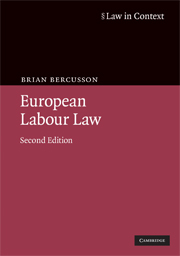Book contents
- Frontmatter
- Contents
- Preface
- Section I Labour law and Europe
- 1 European labour law and the social dimension of the European Union
- 2 EU labour law and the UK
- 3 The conceptualisation of European labour law
- 4 Shifting strategies 1951–1986: ECSC, EEC, harmonisation, financial instruments, qualified majority voting
- 5 The strategy of European social dialogue
- 6 The European Employment Strategy, the open method of coordination and the ‘Lisbon Strategy’
- 7 The strategy of fundamental rights: the EU Charter of Nice 2000 and a ‘constitutional’ strategy
- Section II The structure of European labour law
- Section III The futures of European labour law
- Index
- References
4 - Shifting strategies 1951–1986: ECSC, EEC, harmonisation, financial instruments, qualified majority voting
from Section I - Labour law and Europe
Published online by Cambridge University Press: 05 June 2012
- Frontmatter
- Contents
- Preface
- Section I Labour law and Europe
- 1 European labour law and the social dimension of the European Union
- 2 EU labour law and the UK
- 3 The conceptualisation of European labour law
- 4 Shifting strategies 1951–1986: ECSC, EEC, harmonisation, financial instruments, qualified majority voting
- 5 The strategy of European social dialogue
- 6 The European Employment Strategy, the open method of coordination and the ‘Lisbon Strategy’
- 7 The strategy of fundamental rights: the EU Charter of Nice 2000 and a ‘constitutional’ strategy
- Section II The structure of European labour law
- Section III The futures of European labour law
- Index
- References
Summary
Introduction: Shifting strategies 1951–2008
The history of labour law in the European Union is best understood in the context of the evolution of the European Communities in general since their foundation with the European Coal and Steel Community in 1951. Throughout more than half a century, the Community has experimented with a variety of different legal strategies for the formulation and implementation of labour law and social policy. These strategies responded to different economic and political conjunctures. Whatever may have been the original vision of a particular cohort of national and Community leaders when the Communities were founded, this long period has witnessed dramatic changes in the economic and political context. It is not surprising, therefore, that the labour law and social policy of the Community have reflected these changes.
The striking feature of this history is precisely the great variety of legal strategies which have characterised attempts by the European Communities to achieve a coherent social policy and labour law. To some extent this reflects the dialectic between the common problems facing the labour markets of the Member States and the variety of national contexts and traditions in which these problems are confronted.
One key moment was the period following the oil and energy crises beginning in 1973. Various national labour law systems were confronted with common problems of high unemployment and recession in industry.
- Type
- Chapter
- Information
- European Labour Law , pp. 99 - 125Publisher: Cambridge University PressPrint publication year: 2009

